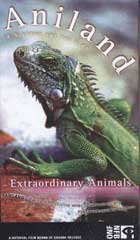
Aniland 2003
Distributed by Bullfrog Films, PO Box 149, Oley, PA 19547; 800-543-FROG (3764)
Produced by Michael Stedman and Paul Terrel
Director n/a
VHS, color, 5 videocassettes, 45-50 min. each
K-8
Animal Behavior, Biology
Date Entered: 07/14/2005
Reviewed by Geetha Yapa, Science Library, University of California, RiversideAniland is a five-part video series that offers rare insights into the fascinating world of animals. Each video covers a different theme, such as Everyday Life, Family, Anatomy, Survival and Extraordinary Animals. Topics under each theme are presented in five minute segments and the entire series includes hundreds of examples from the lives of animals living in different parts of the world.
Each of the segments focuses on a topic related to animal biology, behavior and diversity. Everyday Life is about how animals take care of themselves and how they interact with others. Included are daily activities such as feeding, cleaning, sleeping, communication, locomotion and care of their young. It also provides information about social intelligence, while explaining the difference between intelligence and reflexes. The video on Family features beneficial partnerships between animals from the same or different species. It also focuses on courtship behavior, having babies/offspring, family life, learning from parents and cannibalism.
Extraordinary Animals shows a variety of habitats and conditions under which animals live, ranging from cold Polar Regions to erupting volcanoes, and life on tree tops to thousand of feet under water. Also included are examples of highly organized ant societies, animals that look like monsters, giants on land and sea and great performances by animals. The film explores evolution of life beginning with life under water and the transition to land, highlighting animals that are related to and resemble creatures that lived thousands of years ago. Animals resort to extreme behaviors in order to survive harsh living conditions. Survival covers behavior patterns that include vandalism, stealing, fighting, hunting, scavenging and migration. Also included are ways in which they defend themselves from predators. Anatomy deals with animal diversity. Topics covered include color, advantages of blending with nature, use of color to attract mates, differences in body size, metamorphosis etc. Incredible facts about physical record breakers and anomalies of nature are also presented here.
The series provides fascinating information about the world of animals, and the photography is breathtaking. The narration, shared by a male and a female, is clear and amusing and should keep younger audiences interested. The introduction at the beginning of each segment helps students understand difficult terms, and the fast pace engages student attention. Although there is a certain degree of repetition, most of the segments could be used as supplementary visual teaching tools for a range of classroom topics on animals. Recommended for primary through secondary grades.